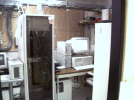Really?
At one of my customers the computer room was the smokers' refuge, and another it was the beer store (double floor, cooled). Both are successful shops, not sure if due to that.
While we are talking about dumb things to do with your raised computer-room floor...
The IBM mainframe shop I worked at in the '70s had IBM 3270 green-screen terminals, and each one required a run of 93-ohm RG62 coaxial cable back to the computer room. In order to plan for expansion, they would run a few extra cables, and they would come out under the computer room floor. So far, so good.
But they didn't label the cables!
So when they needed to add a terminal, they had to run a brand-new cable, because they had hundreds of unused cable ends under the floor, and no way of knowing which one was the other end of the cable they wanted to use.
I always thought they should apply a high-voltage, low-current to the cable, then look under the floor, where it was dark, and see which cable was sparking. But I could never get anyone interested in trying this, and since I was a systems programmer, not a cable installer, they did it the way they did it.
RG62 is rated for a peak voltage of 1.1 KV. If what I am reading is correct to, get an arc in air requires about 3.4 KV per millimeter, more than three times the operating voltage of the cable. Perhaps it would be better to gently spritz the ends of the cables with water and see which one arcs.
Or they could just label the cables when they installed them.
But although the folks running the shop were usually very sharp, occasionally they weren't. For example, the IBM mainframes back then ran on 400 Hz, 3-phase power. They had these devices called Franklin Power Converters that converted the 60 Hz power to 400 Hz. They had a battery input, sort of like a mainframe UPS, but the company didn't buy batteries, because they were too expensive. Now, that could be a valid business decision, except for one thing: back then, if the IBM mainframes lost power, something would get damaged, and you had to get an IBM engineer out to fix it. So losing power was a non-trivial thing, and could delay getting the business going again. (Later IBM mainframes were much more robust; one time a broken pipe dumped a bunch of water into the mainframe. They just turned it off, let it dry out, and wrung out the filters, and it was fine. But the early ones were pretty touchy.)
In any case, the data center I worked in was torn down and turned into a parking lot about 40 years ago, so whatever good and bad ideas they had are of no consequence, except for being interesting memories.

